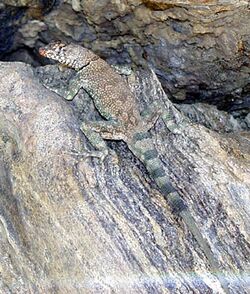Biology:Banded rock lizard
| Banded rock lizard | |
|---|---|

| |
| Scientific classification | |
| Domain: | Eukaryota |
| Kingdom: | Animalia |
| Phylum: | Chordata |
| Class: | Reptilia |
| Order: | Squamata |
| Suborder: | Iguania |
| Family: | Phrynosomatidae |
| Genus: | Petrosaurus |
| Species: | P. mearnsi
|
| Binomial name | |
| Petrosaurus mearnsi (Stejneger, 1894)
| |
| Synonyms[2] | |
| |
The banded rock lizard (Petrosaurus mearnsi ) is a species of lizard in the family Phrynosomatidae.[2] The species is native to western North America.
Etymology
The specific name, mearnsi, is in honor of United States naturalist Edgar Alexander Mearns, who collected the first specimens.[3][4]
Geographic range
P. mearnsi is endemic to extreme southern California and Baja California, Mexico.[5] It also occurs on Isla El Muerto.[1]
Description
P. mearnsi is an extremely flat-bodied lizard. Its dorsum is olive, brown or gray, with white or bluish spots. It has a single black collar, a banded tail, and granular scales on its body, with keeled tail and limb scales. Individuals may be 6.2 to 8.7 cm (2.4 to 3.4 in) long snout-to-vent. Males have more pronounced throat patterns and brighter blue coloring than females.[6]
Habitat
P. mearnsi is associated with boulder hillsides,[6] extending in Baja California to chaparral and pinyon-juniper woodlands.[1]
Diet
P. mearnsi is omnivorous, feeding not only on insects and spiders, but also on buds and flowers.[7]
Reproduction
Gravid females of P. mearnsi lay eggs from June through August. Clutch size varies from 2 to 6 eggs.[7]
References
- ↑ 1.0 1.1 1.2 Hollingsworth B, Hammerson GA (2007). "Petrosaurus mearnsi ". IUCN Red List of Threatened Species 2007: e.T64067A12741153. doi:10.2305/IUCN.UK.2007.RLTS.T64067A12741153.en. https://www.iucnredlist.org/species/64067/12741153.
- ↑ 2.0 2.1 Petrosaurus mearnsi at the Reptarium.cz Reptile Database. Accessed 7 June 2016.
- ↑ Beltz, Ellin (2006). Scientific and Common Names of the Reptiles and Amphibians of North America – Explained. ebeltz.net/herps/biogappx.html.
- ↑ Beolens, Bo; Watkins, Michael; Grayson, Michael (2011). The Eponym Dictionary of Reptiles. Baltimore: Johns Hopkins University Press. xiii + 296 pp. ISBN:978-1-4214-0135-5. (Petrosaurus mearnsi, p. 174).
- ↑ Smith HM, Brodie ED Jr (1982). Reptiles of North America: A Guide to Field Identification. New York: Golden Press. 240 pp. ISBN:0-307-13666-3 (paperback). (Streptosaurus mearnsi, pp. 110-111).
- ↑ 6.0 6.1 "Petrosaurus mearnsi — Banded Rock Lizard". A Field Guide to the Reptiles and Amphibians of Coastal Southern California. U.S. Geological Survey. http://www.werc.usgs.gov/ProjectSubWebPage.aspx?SubWebPageID=54&ProjectID=75&List=SubWebPages&Web=Project_75&Title=A%20Field%20Guide%20to%20the%20Reptiles%20and%20Amphibians%20of%20Coastal%20Southern%20California. Retrieved 7 June 2016.
- ↑ 7.0 7.1 Stebbins RC (2003). A Field Guide to Western Reptiles and Amphibians, Third Edition. The Peterson Field Guide Series®. Boston and New York: Houghton Mifflin. xiii + 533 pp. ISBN:0-395-98272-3 (paperback). (Petrosaurus mearnsi, pp. 298-299 + Plate 32 + Map 100).
Sources
- This article is based on a description from "A Field Guide to the Reptiles and Amphibians of Coastal Southern California", Robert N. Fisher and Ted J. Case, USGS, http://www.werc.usgs.gov/fieldguide/index.htm.
Further reading
- Schulze Niehoff P (2018). "Mearns’ Rock Lizard, Petrosaurus mearnsi (Stejneger, 1894) – its natural history, captive care and first breeding record". Sauria (Berlin) 40 (1): 58–74.
- Stejneger L (1894). "Description of Uta mearnsi, a new Lizard from California". Proceedings of the United States National Museum 17: 589–591. (Uta mearnsi, new species)
Wikidata ☰ Q3200965 entry


